Abstract
This study addresses the mechanism of transport of the H2-receptor antagonist, cimetidine, by the human placenta. A 4-h recycling perfusion of a single placental cotyledon of normal, term, human placenta was used. At a maternal concentration of 1 microgram/ml, cimetidine clearance from the maternal circulation was 0.58 +/- 0.16 ml/min per g placenta, a rate about one third that of antipyrine. There was no evidence of cimetidine metabolism by the placenta. Transfer of cimetidine from maternal to fetal compartments showed no saturation kinetics and was not inhibited by putative carrier competitors. Cimetidine did not accumulate against a drug concentration gradient. Fetal clearance of cimetidine was similar to maternal clearance. Studies with placental apical vesicles confirmed lack of saturability of cimetidine transport and of its concentration within vesicles. Thus, (a) cimetidine is transported across the human placenta bidirectionally at a rate about one third that of antipyrine, (b) the drug is not metabolized by the placenta, and (c) the transport is a passive one.
Full text
PDF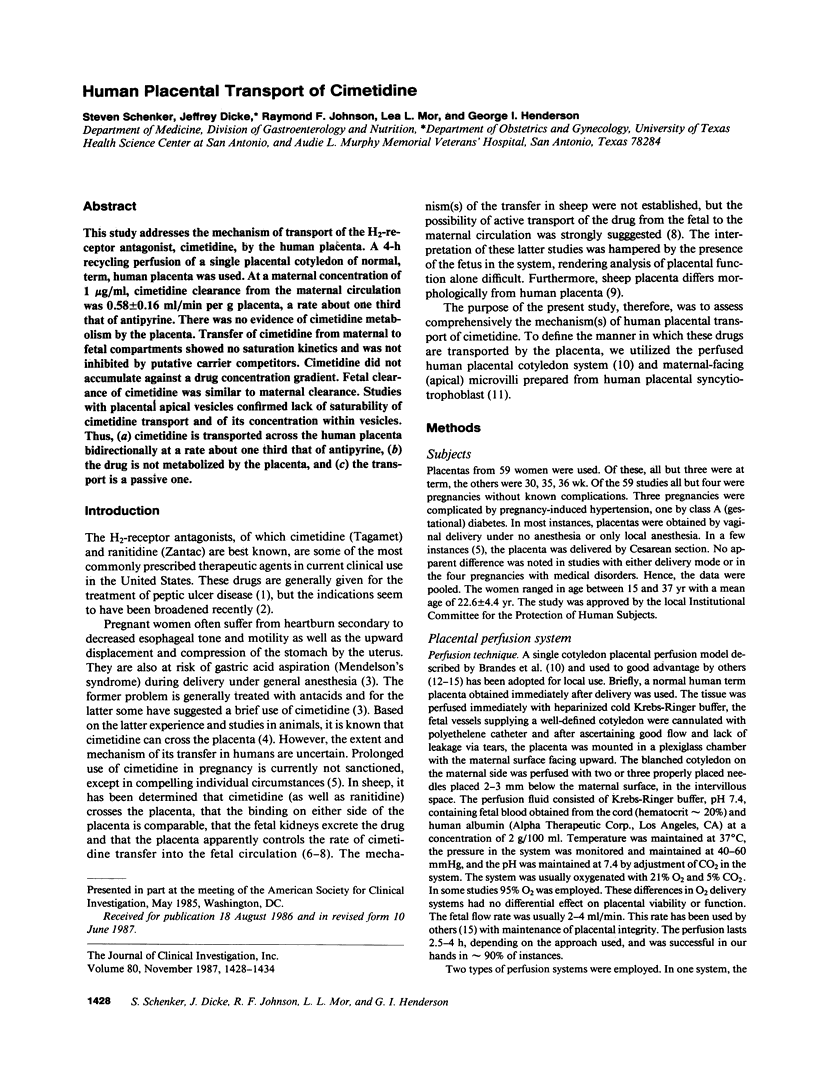
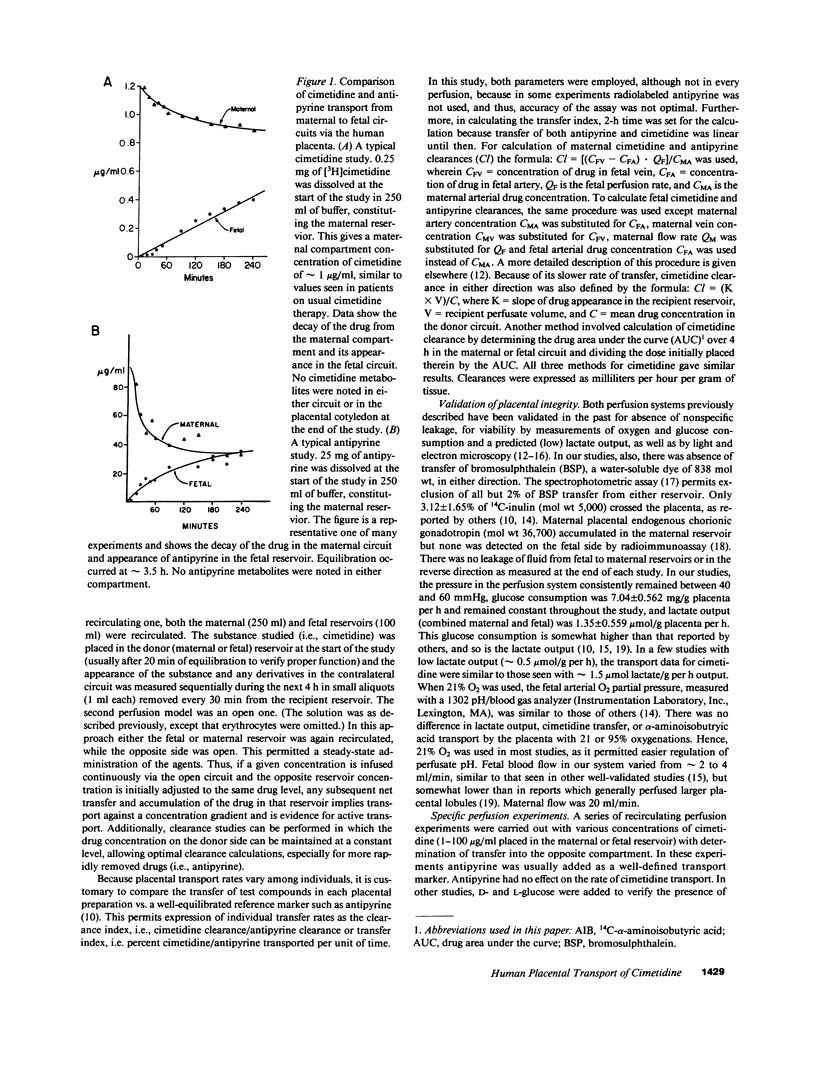
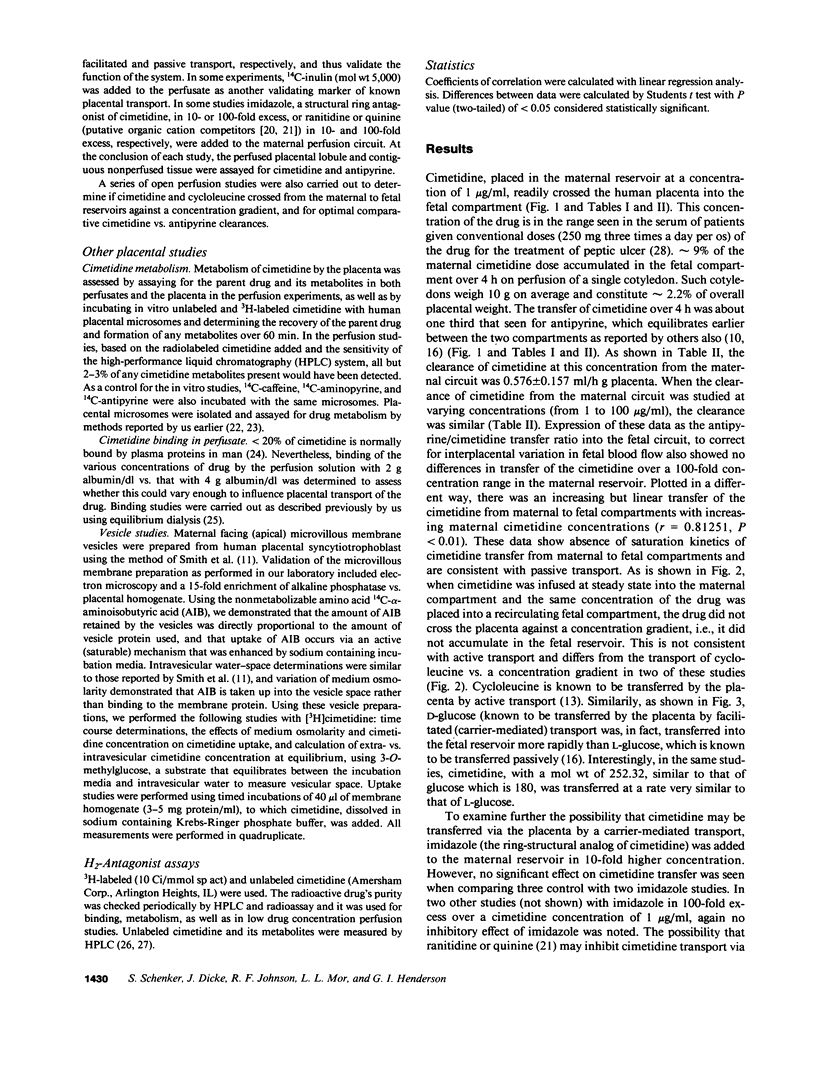
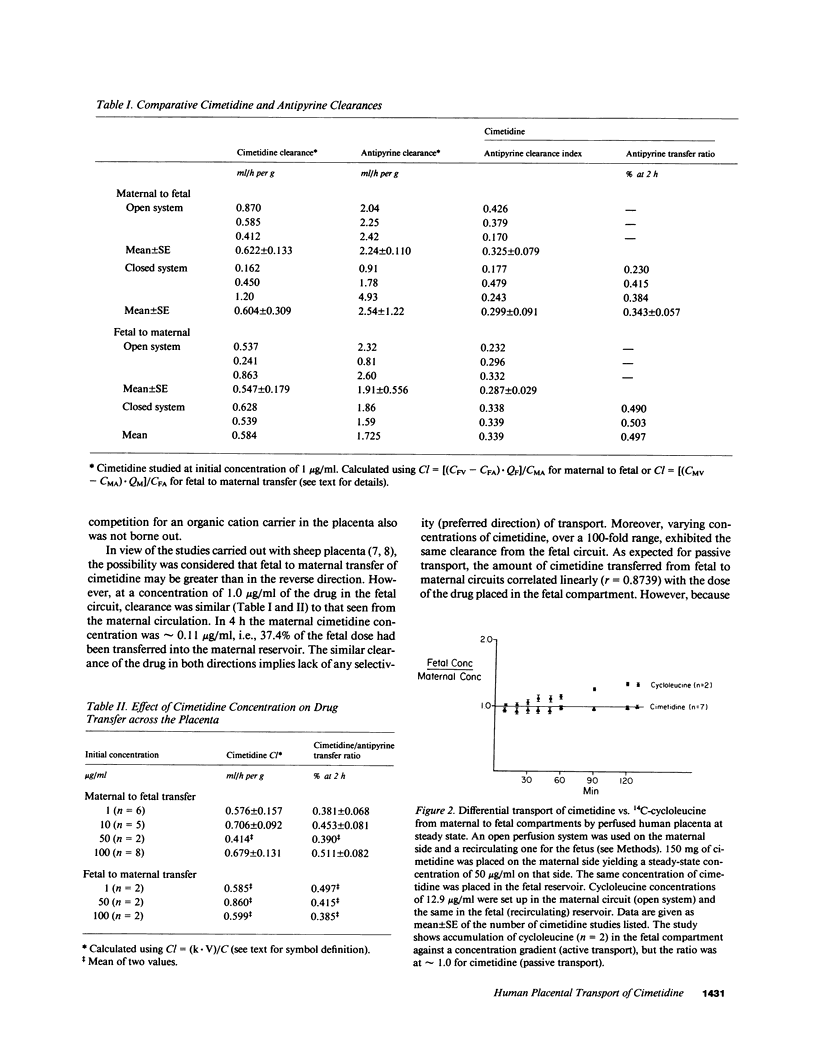
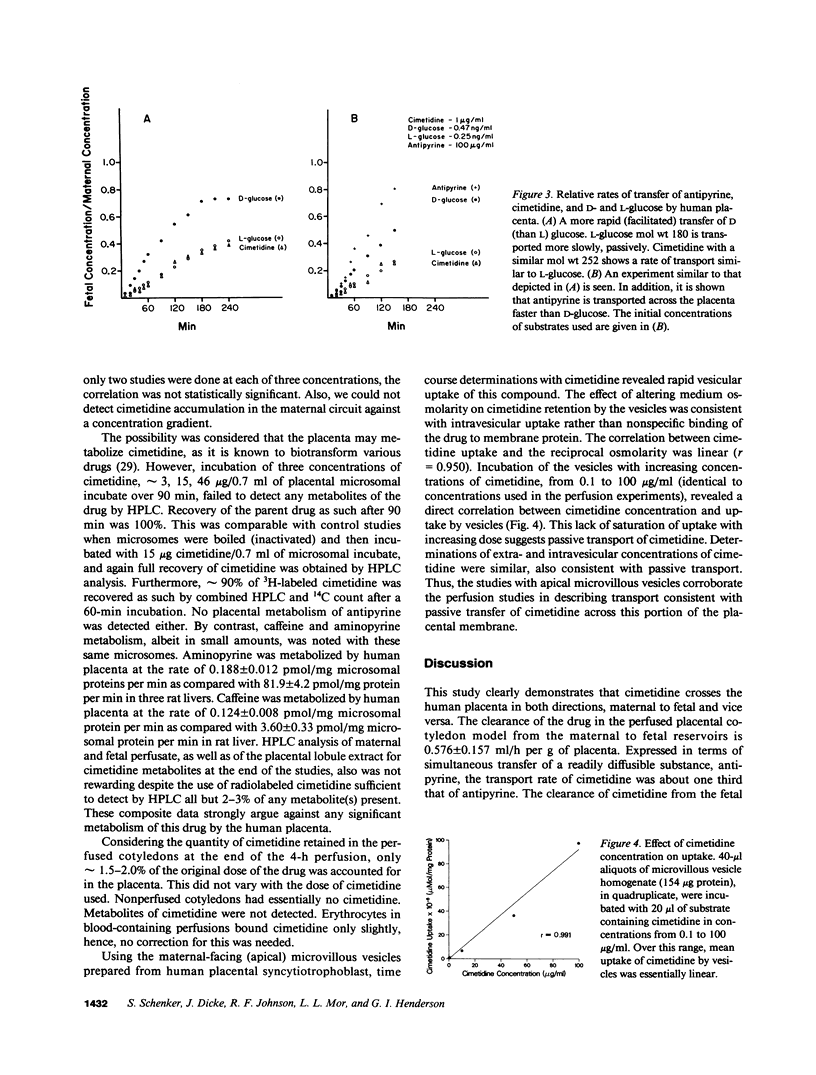
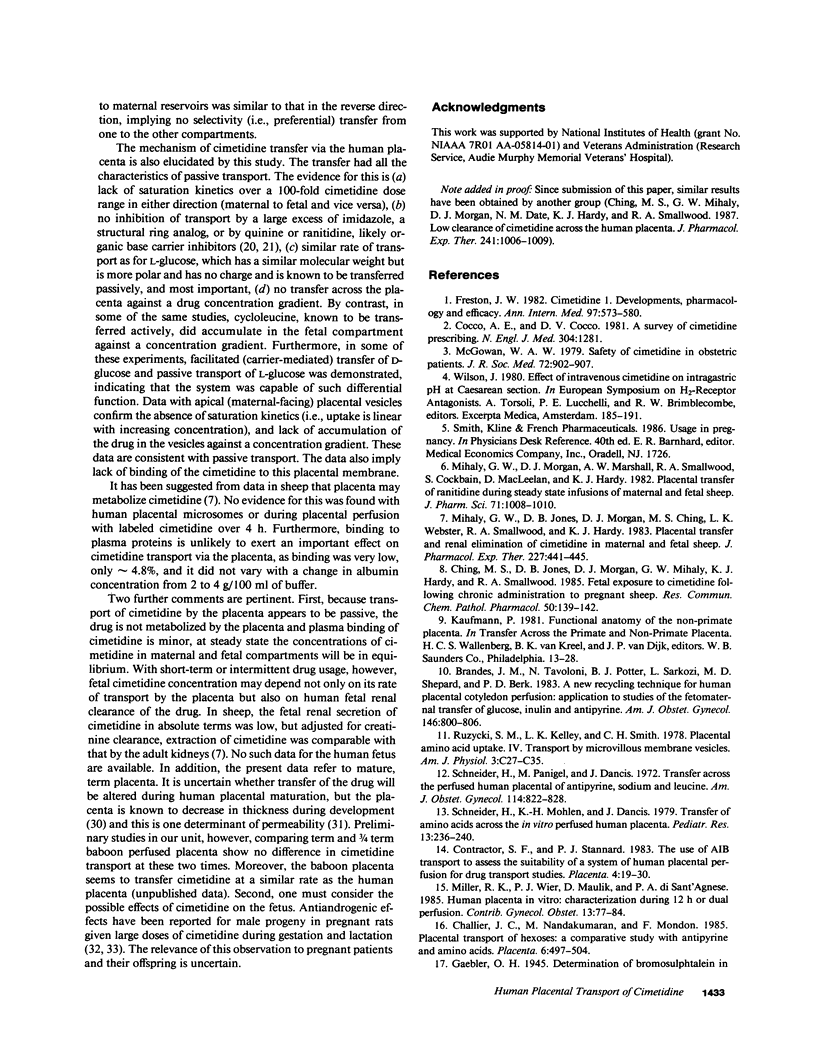
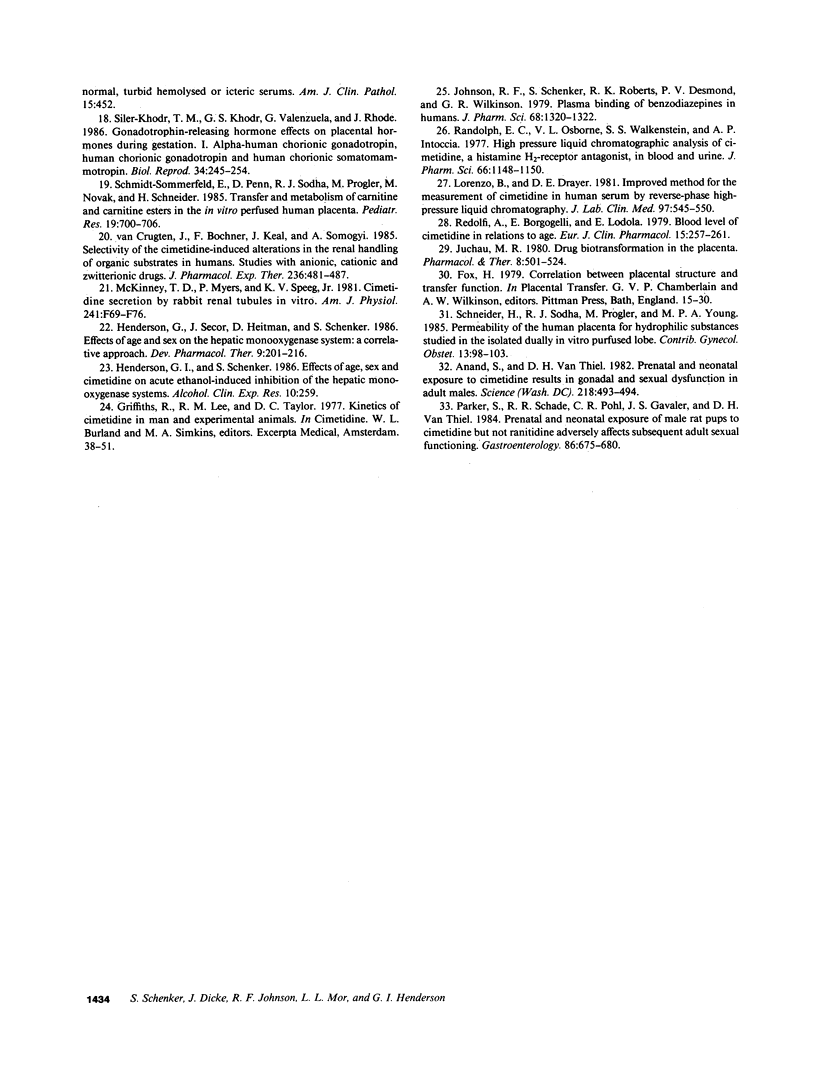
Selected References
These references are in PubMed. This may not be the complete list of references from this article.
- Anand S., Van Thiel D. H. Prenatal and neonatal exposure to cimetidine results in gonadal and sexual dysfunction in adult males. Science. 1982 Oct 29;218(4571):493–494. doi: 10.1126/science.7123252. [DOI] [PubMed] [Google Scholar]
- Brandes J. M., Tavoloni N., Potter B. J., Sarkozi L., Shepard M. D., Berk P. D. A new recycling technique for human placental cotyledon perfusion: application to studies of the fetomaternal transfer of glucose, inulin, and antipyrine. Am J Obstet Gynecol. 1983 Aug 1;146(7):800–806. doi: 10.1016/0002-9378(83)91081-5. [DOI] [PubMed] [Google Scholar]
- Challier J. C., Nandakumaran M., Mondon F. Placental transport of hexoses: a comparative study with antipyrine and amino acids. Placenta. 1985 Nov-Dec;6(6):497–504. doi: 10.1016/s0143-4004(85)80003-5. [DOI] [PubMed] [Google Scholar]
- Ching M. S., Jones D. B., Morgan D. J., Mihaly G. W., Hardy K. J., Smallwood R. A. Fetal exposure to cimetidine following chronic administration to pregnant sheep. Res Commun Chem Pathol Pharmacol. 1985 Oct;50(1):139–142. [PubMed] [Google Scholar]
- Ching M. S., Mihaly G. W., Morgan D. J., Date N. M., Hardy K. J., Smallwood R. A. Low clearance of cimetidine across the human placenta. J Pharmacol Exp Ther. 1987 Jun;241(3):1006–1009. [PubMed] [Google Scholar]
- Contractor S. F., Stannard P. J. The use of AIB transport to assess the suitability of a system of human placental perfusion for drug transport studies. Placenta. 1983 Jan-Apr;4(1):19–29. doi: 10.1016/s0143-4004(83)80014-9. [DOI] [PubMed] [Google Scholar]
- Freston J. W. Cimetidine. I. Developments, pharmacology, and efficacy. Ann Intern Med. 1982 Oct;97(4):573–580. doi: 10.7326/0003-4819-97-4-573. [DOI] [PubMed] [Google Scholar]
- Henderson G. I., Schenker S. Effects of age, sex, and cimetidine on acute ethanol-induced inhibition of the hepatic monooxygenase systems. Alcohol Clin Exp Res. 1986 Jun;10(3):259–265. doi: 10.1111/j.1530-0277.1986.tb05086.x. [DOI] [PubMed] [Google Scholar]
- Henderson G., Secor J., Heitman D., Schenker S. Effects of age and sex on the hepatic monoxygenase system: a correlative approach. Dev Pharmacol Ther. 1986;9(3):201–216. doi: 10.1159/000457093. [DOI] [PubMed] [Google Scholar]
- Johnson R. F., Schenker S., Roberts R. K., Desmond P. V., Wilkinson G. R. Plasma binding of benzodiazepines in humans. J Pharm Sci. 1979 Oct;68(10):1320–1322. doi: 10.1002/jps.2600681034. [DOI] [PubMed] [Google Scholar]
- Juchau M. R. Drug biotransformation in the placenta. Pharmacol Ther. 1980;8(3):501–524. doi: 10.1016/0163-7258(80)90074-1. [DOI] [PubMed] [Google Scholar]
- Lorenzo B., Drayer D. E. Improved method for the measurement of cimetidine in human serum by reverse-phase high-pressure liquid chromatography. J Lab Clin Med. 1981 Apr;97(4):545–550. [PubMed] [Google Scholar]
- McGowan W. A. Safety of cimetidine in obstetric patients. J R Soc Med. 1979 Dec;72(12):902–907. doi: 10.1177/014107687907201208. [DOI] [PMC free article] [PubMed] [Google Scholar]
- McKinney T. D., Myers P., Speeg K. V., Jr Cimetidine secretion by rabbit renal tubules in vitro. Am J Physiol. 1981 Jul;241(1):F69–F76. doi: 10.1152/ajprenal.1981.241.1.F69. [DOI] [PubMed] [Google Scholar]
- Mihaly G. W., Jones D. B., Morgan D. J., Ching M. S., Webster L. K., Smallwood R. A., Hardy K. J. Placental transfer and renal elimination of cimetidine in maternal and fetal sheep. J Pharmacol Exp Ther. 1983 Nov;227(2):441–445. [PubMed] [Google Scholar]
- Mihaly G. W., Morgan D. J., Marshall A. W., Smallwood R. A., Cockbain S., MacLellan D., Hardy K. J. Placental transfer of ranitidine during steady-state infusions of maternal and fetal sheep. J Pharm Sci. 1982 Sep;71(9):1008–1010. doi: 10.1002/jps.2600710913. [DOI] [PubMed] [Google Scholar]
- Miller R. K., Wier P. J., Maulik D., di Sant'Agnese P. A. Human placenta in vitro: characterization during 12 h of dual perfusion. Contrib Gynecol Obstet. 1985;13:77–84. [PubMed] [Google Scholar]
- Parker S., Schade R. R., Pohl C. R., Gavaler J. S., Van Thiel D. H. Prenatal and neonatal exposure of male rat pups to cimetidine but not ranitidine adversely affects subsequent adult sexual functioning. Gastroenterology. 1984 Apr;86(4):675–680. [PubMed] [Google Scholar]
- Randolph W. C., Osborne V. L., Walkenstein S. S., Intoccia A. P. High-pressure liquid chromatographic analysis of cimetidine, a histamine H2-receptor antagonist, in blood and urine. J Pharm Sci. 1977 Aug;66(8):1148–1150. doi: 10.1002/jps.2600660825. [DOI] [PubMed] [Google Scholar]
- Redolfi A., Borgogelli E., Lodola E. Blood level of cimetidine in relation to age. Eur J Clin Pharmacol. 1979 May 21;15(4):257–261. doi: 10.1007/BF00618514. [DOI] [PubMed] [Google Scholar]
- Ruzycki S. M., Kelley L. K., Smith C. H. Placental amino acid uptake. IV. Transport microvillous membrane vesicles. Am J Physiol. 1978 Jan;234(1):C27–C35. doi: 10.1152/ajpcell.1978.234.1.C27. [DOI] [PubMed] [Google Scholar]
- Schmidt-Sommerfeld E., Penn D., Sodha R. J., Prögler M., Novak M., Schneider H. Transfer and metabolism of carnitine and carnitine esters in the in vitro perfused human placenta. Pediatr Res. 1985 Jul;19(7):700–706. doi: 10.1203/00006450-198507000-00013. [DOI] [PubMed] [Google Scholar]
- Schneider H., Möhlen K. H., Dancis J. Transfer of amino acids across the in vitro perfused human placenta. Pediatr Res. 1979 Apr;13(4 Pt 1):236–240. doi: 10.1203/00006450-197904000-00005. [DOI] [PubMed] [Google Scholar]
- Schneider H., Panigel M., Dancis J. Transfer across the perfused human placenta of antipyrine, sodium and leucine. Am J Obstet Gynecol. 1972 Nov 15;114(6):822–828. doi: 10.1016/0002-9378(72)90909-x. [DOI] [PubMed] [Google Scholar]
- Schneider H., Sodha R. J., Prögler M., Young M. P. Permeability of the human placenta for hydrophilic substances studied in the isolated dually in vitro perfused lobe. Contrib Gynecol Obstet. 1985;13:98–103. [PubMed] [Google Scholar]
- Siler-Khodr T. M., Khodr G. S., Valenzuela G., Rhode J. Gonadotropin-releasing hormone effects on placental hormones during gestation: I. Alpha-human chorionic gonadotropin, human chorionic gonadotropin and human chorionic somatomammotropin. Biol Reprod. 1986 Mar;34(2):245–254. doi: 10.1095/biolreprod34.2.245. [DOI] [PubMed] [Google Scholar]
- van Crugten J., Bochner F., Keal J., Somogyi A. Selectivity of the cimetidine-induced alterations in the renal handling of organic substrates in humans. Studies with anionic, cationic and zwitterionic drugs. J Pharmacol Exp Ther. 1986 Feb;236(2):481–487. [PubMed] [Google Scholar]


